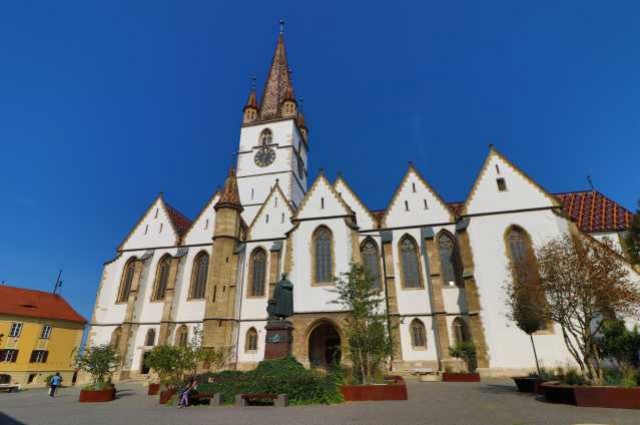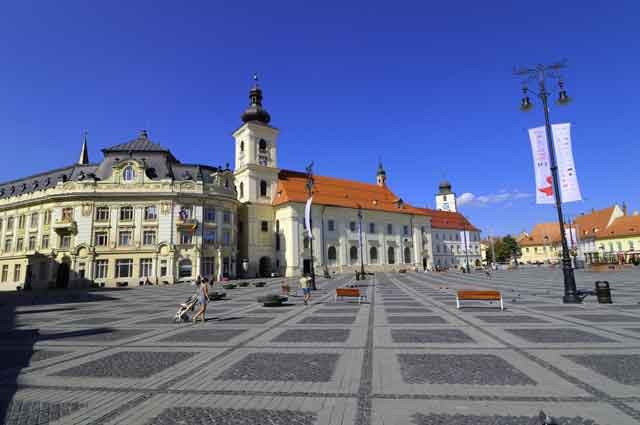Brasov
Brașov is a charming medieval city in Romania, nestled in the Carpathian Mountains. Known for its stunning architecture, including the Black Church and Council Square, it offers a perfect blend of history, culture, and natural beauty. A must-visit destination for any traveler exploring Romania. It is a perfect base for your trip in Romania.
HighlightsBlack Church, Council Square, Weaver's Bastion, St. Nicholas Church, Ecaterina's Gate, Schei Gate, Towers and the medieval wall, Tampa mountain, Poiana Brasov
Short History of Brasov
Brașov, one of the most beautiful and historically rich cities in Romania, has a fascinating past that dates back to the 13th century. Located in the heart of Transylvania, this medieval city was founded by the Teutonic Knights in 1211 under the order of King Andrew II of Hungary. It soon became a significant commercial and cultural center, attracting settlers from various ethnic backgrounds, including Saxons, Hungarians, and Romanians.
During the Middle Ages, Brașov flourished as a major trading hub due to its strategic location on important trade routes connecting Western Europe with the Ottoman Empire. The Saxon settlers built impressive fortifications to protect the city, including strong defensive walls, bastions, and towers. The Black Church, the most famous Gothic monument in Romania, was built during this time and remains one of the city's most iconic landmarks.
Brașov played a crucial role in the cultural and political life of Transylvania. In the 16th century, it became a center for printing and education, with the first Romanian-language book printed here by Deacon Coresi. The city also played a key part in Romania’s struggle for national unity, with revolutionaries such as Andrei Șaguna advocating for the rights of Romanians in Transylvania.
Throughout its history, Brașov experienced periods of prosperity and hardship. During the Austro-Hungarian rule in the 19th century, the city continued to develop, with the construction of elegant buildings and modern infrastructure. After World War I, Brașov became part of Romania, and in the communist era, it underwent rapid industrialization.
Today, Brașov is one of Romania’s top tourist destinations, attracting visitors with its well-preserved medieval architecture, vibrant cultural scene, and proximity to the Carpathian Mountains. The old town, with its charming squares, historical landmarks, and cobbled streets, offers a glimpse into the city's rich past. Whether exploring the Black Church, walking along the ancient city walls, or taking a cable car ride to Mount Tâmpa, visitors can experience the unique blend of history and natural beauty that defines Brașov.
It is a mandatory stop for any tour of Romania.
Council Square and Council House

Council Square (Piața Sfatului) and the Council House (Casa Sfatului) in Brașov are two of the most important and iconic attractions in the city, offering visitors a fascinating glimpse into its medieval history and the vibrant atmosphere of the Old Town.
Council Square, also known as the Great Square, is the historical heart of Brașov. Over the centuries, it has witnessed numerous important events, including markets, public gatherings, and cultural events. The square was once the center of commerce and social life, and today, it remains a lively place where both locals and tourists gather to enjoy the atmosphere and explore the surrounding historic buildings.
One of the most significant buildings surrounding Council Square is the Council House, an impressive structure with a remarkable history. Built in the 15th century, the Council House served as the seat of the city authorities and the local council. Over time, the building was expanded and renovated, but it has retained its medieval charm, making it a true architectural gem. Today, the Council House houses the Brașov History Museum, a place where visitors can learn about the city’s development from its founding to the present day.
The Council House stands out with its Gothic architecture, showcasing details characteristic of the medieval period. Its façade is adorned with ironwork, and the building’s tower, known as the Council Tower, offers a panoramic view of the square and the city. The tower was historically used as an observation point for city defense and as a watchtower to warn residents of any danger.
It is recommended to choose a hotel in or in the proximity of the Council Square for a better experience of your vacation time in Brasov.
Black Church

The Black Church (Biserica Neagră) in Brașov is one of the most significant landmarks in Romania, both in terms of its historical importance and architectural beauty. Standing proudly in the heart of the city, it is a symbol of Brașov’s rich cultural and religious heritage, attracting visitors from all over the world.
The church’s history dates back to the late 14th century, when it was originally built as a Catholic church dedicated to the Virgin Mary. The Black Church, however, earned its name after a devastating fire in 1689, which destroyed much of the city and left the church’s walls blackened by smoke and soot. Despite the extensive damage, the church was later restored and remained a key place of worship, eventually becoming a Lutheran church after the Protestant Reformation.
Architecturally, the Black Church is a masterpiece of Gothic style, with its towering spire and intricate details. The building is notable for its impressive size, being one of the largest churches in the region. The interior of the church is equally stunning, with a magnificent altar, a collection of medieval wall paintings, and a series of intricately carved pews. One of the church’s most famous features is its pipe organ, which is considered one of the largest in Europe, with over 4,000 pipes.
The Black Church is also home to an important collection of artifacts, including religious items and textiles, which reflect the city’s historical connection to the Lutheran faith. In addition, the church’s bell tower offers visitors a spectacular view of the surrounding area, including the Old Town and the Carpathian Mountains.
Today, the Black Church remains an active place of worship and is one of Brașov’s most visited attractions. It holds regular services and hosts concerts, particularly organ recitals, making it a cultural and religious center for both locals and tourists. The church’s rich history, impressive architecture, and role as a cultural hub make it an essential stop for anyone exploring Brașov.
Medieval Fortifications of Brasov


The medieval walls, towers, bastions, and gates of Brașov are some of the most impressive historical landmarks in Transylvania, offering a fascinating journey into the city’s fortified past. Built between the 15th and 17th centuries, these defensive structures played a crucial role in protecting Brașov from invaders and preserving its status as an important commercial and cultural center. Today, they remain a testament to the city's medieval strength and architectural ingenuity.
The Fortified Walls and Towers
Brașov’s medieval walls originally encircled the entire city, forming a strong and imposing defensive system. Made of stone and brick, these walls were up to 12 meters high and several meters thick, with numerous towers and bastions providing additional protection. Although parts of the walls have been lost over time, large sections still remain, allowing visitors to experience the city’s historic fortifications firsthand.
Among the most famous defensive towers are the White Tower (Turnul Alb) and the Black Tower (Turnul Negru). The White Tower, standing on a hill above the city, provided a crucial lookout point and offers panoramic views of Brașov today. The Black Tower, which was struck by lightning and partially burned in the past, is not entirely black but retains its historical significance as part of the city’s fortifications. Both towers now serve as museums, showcasing medieval artifacts and offering insight into Brașov’s defensive history.
The Bastions of Brașov
The city’s defense system also included a series of bastions, built and maintained by Brașov’s powerful guilds. These bastions served as additional strongholds, each assigned to different groups of craftsmen who took responsibility for their upkeep and defense. Some of the best-preserved bastions include:
Weavers’ Bastion (Bastionul Țesătorilor) – One of the largest and best-preserved bastions in Brașov, built and maintained by the city’s weavers’ guild. Today, it houses a museum showcasing Brașov’s medieval history and the impressive model of the city’s old fortifications.
Blacksmiths’ Bastion (Bastionul Fierarilor) – Located near the Black Church, this bastion played a key role in defending the southern part of the city.
Graft Bastion (Bastionul Graft) – Connecting the White Tower to the rest of the fortifications, this bastion was essential for city defense and has been restored for visitors to explore.
The Medieval Gates of Brașov
Brașov’s fortified walls also featured several gates, controlling access to the city and ensuring security. The most famous of these include:
Catherine’s Gate (Poarta Ecaterinei) – Built in the 16th century, this is the only remaining original city gate. Its distinctive fairy-tale-like towers make it one of the most picturesque landmarks in Brașov. The four small towers on top symbolized the city's right to administer justice, including capital punishment.
Schei Gate (Poarta Schei) – Constructed later in the 19th century, this gate was built to allow Romanian residents to enter the city, as they were historically restricted from using Catherine’s Gate.
Brașov’s Fortifications Today
Today, Brașov’s medieval walls, towers, bastions, and gates stand as remarkable relics of the city’s rich past. Walking along the fortifications, visitors can immerse themselves in the medieval atmosphere while enjoying breathtaking views of the surrounding Carpathian Mountains. These historical landmarks not only highlight Brașov’s strategic importance but also serve as a cultural treasure for Romania, making the city a must-visit destination for history enthusiasts and travelers alike. They can be easily seen in a walking tour of Brasov.
First Romanian School and St. Nicholas Cathedral
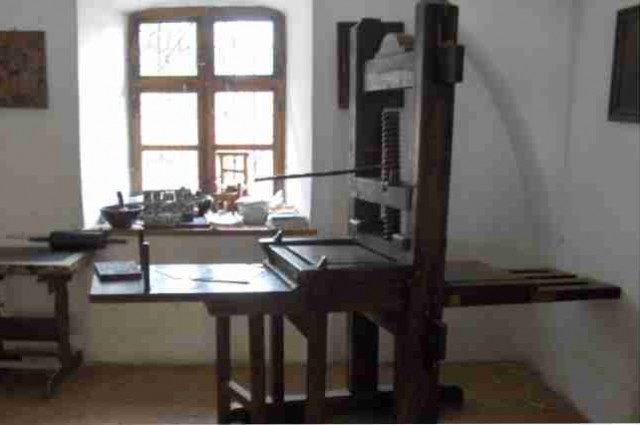
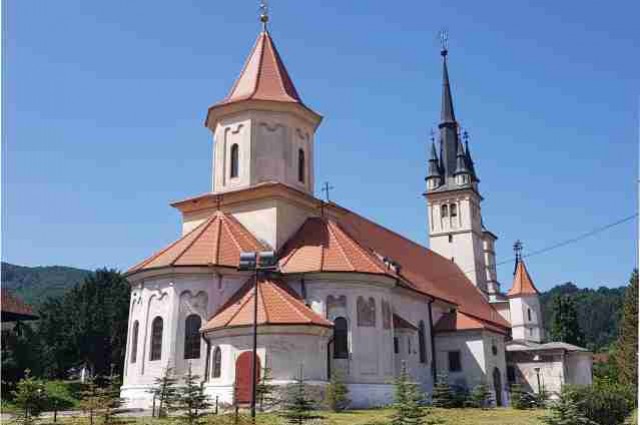
The First Romanian School and Saint Nicholas Church are two of the most significant historical and cultural landmarks in Brașov, located in the picturesque Șcheii Brașovului district. These sites offer a deep insight into the city’s educational and religious heritage, marking key moments in the development of Romanian language, literature, and Orthodox traditions.
The First Romanian School – A Center of Education and Culture
The First Romanian School, established in the late 16th century, is an emblematic institution for Romanian history. Located within the Saint Nicholas Church complex, it was the first documented school where teaching was conducted in Romanian, marking a crucial step in preserving and developing the national identity.
One of the most remarkable figures associated with the school is Diaconul Coresi, a scholar and printer who worked tirelessly to translate and print some of the first Romanian-language books. His contributions helped spread literacy and Orthodox teachings among Romanians at a time when most religious and educational texts were written in Old Church Slavonic.
Today, the school functions as a museum, displaying a collection of old manuscripts, the first printed books in Romanian, and original wooden desks used by students centuries ago. Visitors can explore historic classrooms and admire the vast collection of cultural artifacts, including old printing presses and religious documents. The museum also houses rare paintings, icons, and exhibits showcasing the evolution of Romanian education over the centuries.
Saint Nicholas Church – A Jewel of Orthodox Architecture
Right next to the First Romanian School stands Saint Nicholas Church, one of the most impressive Orthodox churches in Transylvania. Originally built in the 14th century from wood, the church was later reconstructed in stone in a blend of Gothic and Baroque styles, with stunning frescoes and intricate architectural details.
The church has long been a spiritual and cultural center for the Romanian community in Brașov. Over the centuries, it has been expanded and adorned with beautiful Byzantine-style frescoes, which depict religious scenes and historical figures. The church’s iconostasis, richly decorated with gold and intricate carvings, is one of its most striking features.
Many prominent historical figures have been associated with Saint Nicholas Church, including Romanian rulers and scholars who contributed to the development of national culture and education. The churchyard also houses several important tombstones and monuments dedicated to significant personalities in Romanian history.
Hiking in the surroundings of Brasov
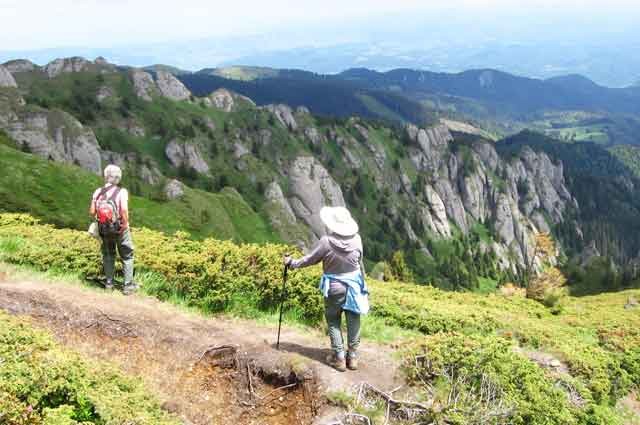



Nestled in the heart of Romania, Brasov is a gateway to some of the most breathtaking natural landscapes in the Carpathian Mountains. For hiking enthusiasts and nature lovers, the region offers an abundance of trails, dense forests, and panoramic views that make every outdoor adventure unforgettable.
One of the most popular hiking destinations near Brasov is Tampa Mountain. This iconic peak, rising 960 meters above sea level, offers a relatively short but rewarding hike. The well-marked trails lead to a spectacular viewpoint where hikers can admire the stunning aerial view of Brasov’s medieval Old Town. For those who prefer a more relaxed ascent, a cable car is also available.
A more challenging option is the hike to Piatra Mare, a 1,843-meter peak known for its breathtaking scenery and diverse terrain. The trail takes adventurers through dense forests, past the Seven Ladders Canyon—a stunning series of metal ladders and bridges over cascading waterfalls—and up to the summit, where panoramic views of the surrounding valleys and peaks await.
For those seeking a true wilderness experience, the Bucegi Mountains, located just south of Brasov, provide numerous hiking routes of varying difficulty. One of the most famous trails leads to the Sphinx and Babele, two unusual rock formations shrouded in mystery and legend. Other routes in the area lead to stunning glacial lakes and alpine meadows, making it a paradise for nature photographers and wildlife enthusiasts.
The Piatra Craiului National Park, west of Brasov, is another must-visit destination for hikers. This rugged limestone mountain range is home to some of Romania’s most dramatic landscapes, with narrow ridges, deep gorges, and diverse flora and fauna. The hike to the Piatra Craiului Ridge is demanding but offers some of the most spectacular views in the country.
Hiking around Brasov is not just about the physical challenge; it’s an opportunity to immerse yourself in nature, breathe in the crisp mountain air, and enjoy the tranquility of Romania’s wild beauty. Whether you’re a seasoned hiker or a casual explorer, the trails around Brasov promise an unforgettable adventure.
Wildlife



Beyond hiking, the Brasov region is also an excellent destination for wildlife observation. The forests surrounding the city are home to a rich variety of species, including brown bears, lynxes, deer, and numerous bird species. One of the best ways to safely observe Romania’s majestic brown bears in their natural habitat is through guided bear-watching tours. Several specialized operators organize ethical tours, taking visitors to hidden forest observation points where bears can be seen from a safe distance.
For those interested in conservation, the Libearty Bear Sanctuary in Zarnesti is a must-visit. This sanctuary rescues and rehabilitates bears that have suffered from captivity or mistreatment, offering them a safe and natural environment. Guided tours educate visitors on the importance of wildlife protection while allowing them to see these magnificent animals up close.
Birdwatching enthusiasts will find a hidden gem in Dumbravita, a protected wetland area just a short drive from Brasov. Recognized as a Natura 2000 site, this location is home to over 200 bird species, including rare and migratory birds. Whether you’re an experienced birder or just a casual observer, the tranquil surroundings and diverse avian life make Dumbravita a fantastic spot for nature exploration.
Hiking, wildlife observation, and birdwatching around Brasov offer a unique opportunity to connect with nature and experience the region’s remarkable biodiversity. Whether trekking through mountain trails, watching bears in the wild, or spotting rare birds in the wetlands, the Brasov area promises unforgettable encounters with Romania’s natural beauty.
Rural Tourism in Brasov County

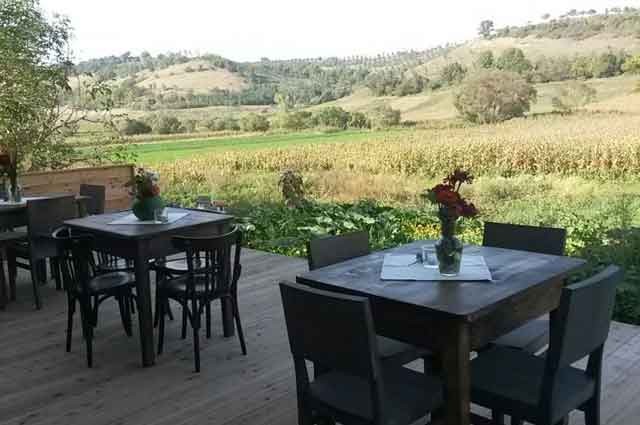


The region also offers rich opportunities for rural tourism, allowing visitors to experience traditional Romanian life, culture, and hospitality.
The picturesque villages surrounding Brasov, such as Viscri, Fundata, Moieciu, and Magura, provide an authentic glimpse into Romania’s rural heritage. These villages, nestled among rolling hills and lush pastures, are home to well-preserved traditional houses, wooden churches, and welcoming locals who still follow age-old customs and crafts.
Viscri, a UNESCO World Heritage Site, is one of the most famous rural destinations in the area. Known for its fortified Saxon church and charming village atmosphere, Viscri is a perfect place to experience traditional crafts such as blacksmithing and weaving. Visitors can also enjoy homemade food prepared with locally sourced ingredients, offering an authentic taste of Transylvania. We are very lucky because Viscri is just one of the many other charming villages existing in the area which all have a great potential for rural, eco-friendly and sustainable tourism.
For those looking to immerse themselves in nature while enjoying rural life, Sirnea, Fundata and Moieciu are excellent choices. Located at the foot of the Bucegi Mountains, these villages offer stunning landscapes, fresh mountain air, and plenty of opportunities for outdoor activities. Visitors can stay in cozy guesthouses, hike through green meadows, or even take part in traditional farming activities.
Pestera & Magura, situated near the Piatra Craiului National Park, are another idyllic destination. This villages are ideal for those seeking peace and tranquility while being close to nature. Horseback riding, cheese tasting at local farms, and exploring the surrounding forests are just some of the experiences that make a visit to Magura unforgettable.
Rural tourism near Brasov is not just about scenic landscapes; it’s a journey into a simpler way of life, where traditions are cherished and nature is respected. Whether enjoying homemade delicacies, staying in traditional guesthouses, or exploring the breathtaking countryside, visitors will find that the rural charm of this region is both relaxing and enriching.
Day trips around Brasov

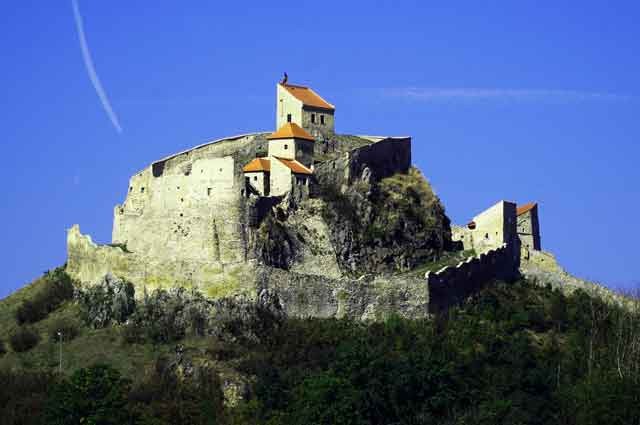



Brasov, with its strategic location in the heart of Romania, is the perfect base for exploring some of the country's most fascinating historical and cultural landmarks. Surrounded by stunning landscapes, medieval towns, and impressive castles, Brasov offers easy access to a variety of unforgettable day trips. Whether you're interested in history, architecture, or breathtaking scenery, the surrounding region has something for everyone.
One of the most captivating day trips from Brasov is a visit to the fortified churches of Transylvania. Scattered across the countryside, these impressive structures date back to the medieval period and were built by Saxon settlers for defense against invaders. The most famous of them are included in the UNESCO World Heritages List such as the church in Viscri, known for its well-preserved architecture and authentic village atmosphere and the fortified churches include Prejmer and Harman, both located just a short drive from Brasov, offering visitors a glimpse into the region’s rich heritage.
No trip to Brasov is complete without visiting Bran Castle, one of Romania’s most famous landmarks. Often associated with the Dracula legend, this imposing fortress is perched on a rocky hilltop and surrounded by dense forests. Inside, visitors can explore its medieval corridors, secret passageways, and royal chambers while learning about its fascinating history. A short drive from Bran lies Rasnov Fortress, another remarkable medieval site that offers stunning panoramic views of the surrounding mountains and valleys.
Another must-see destination is Peles Castle, located in the picturesque mountain resort of Sinaia. Considered one of the most beautiful castles in Europe, Peles Castle was once the summer residence of Romania’s royal family. The castle’s exquisite architecture, lavish interior, and scenic surroundings make it an unforgettable stop on any day tour from Brasov.
For those interested in medieval towns, a trip to Sighisoara and the Tarnava Valley is a perfect choice. Sighisoara, a UNESCO World Heritage Site, is one of the best-preserved medieval citadels in Europe and the birthplace of Vlad the Impaler, the historical figure who inspired Bram Stoker’s Dracula. The colorful streets, ancient towers, and charming squares transport visitors back in time. The nearby Tarnava Valley is home to charming Saxon villages, rolling vineyards, and more fortified churches, making it an ideal extension of the Sighisoara trip.
Another fantastic day trip from Brasov is a visit to Fagaras and Sibiu. Fagaras Fortress, one of the most impressive Renaissance fortifications in Romania, is located just an hour away from Brasov. Once a stronghold against Ottoman invasions, the fortress now houses a fascinating museum. Further west, Sibiu awaits with its stunning architecture, vibrant cultural scene, and charming old town. Known as one of Romania’s most beautiful cities, Sibiu features grand squares, baroque buildings, and the famous Bridge of Lies, making it a perfect place to wander and soak in the local atmosphere.
With so many incredible destinations within easy reach, Brasov is undoubtedly the best base for exploring South-East of Transylvania with it's rich history, culture, and landscapes. Whether you prefer medieval fortresses, fairytale castles, or charming villages, the region surrounding Brasov promises a wealth of unforgettable experiences.

